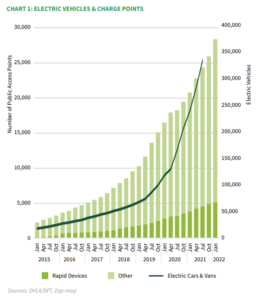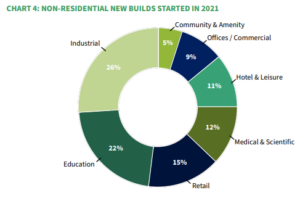Glenigan, one of the construction industry’s leading insight experts, has released its report on EV Infrastructure and Charging: Increasing Opportunities for Operators and Installers.
This proprietary report explores the state of the nation’s electric vehicle infrastructure, offering a contemporary snapshot of how the UK is supporting the rise of EVs for commercial and residential use through the establishment of charging point networks.
The report has been built from Glenigan construction planning data and publically available information from a range of official sources, subsequently analysed by Glenigan’s Economics Team, led by Economic Director, Allan Wilen.

Drilling down, the Report also highlights where future investment in EV infrastructure will come from and currently planned activity to strengthen the UK’s EVCP Network.
Stalling Progress
Following an in-depth analysis of the current EV landscape, Glenigan has uncovered a sizeable deficit of EVCPs in relation to the amount of vehicles currently being manufactured and registered in the UK.
The numbers show that in 2021 an almost 100% increase in the number of EVs sold in the last year was met with a mere 27% increase in the amount of EVCPs during the same period.

Currently EVCP installation just cannot keep pace, particularly the rate at which rapid charging devices are being deployed, holding back progress towards a greener transport system.
According to Glenigan’s Economic Director Allan Wilen, while this situation persists, it will hold back nationwide adoption, he says, “It’s true that most EV Owners will typically charge vehicles at home, if consumer, and at the depot if commercial, meaning rapid charge points won’t be required for short journeys. However for long-distance travel, the distinct lack of EVCPs has created ‘range anxiety’, acting as a major uptake barrier. Ultimately, the rapid transition to EVs will only occur if drivers are confident they can access public charge points in remote, as well as densely populated areas.”
Super-Charging
EV Infrastructure and Charging: Increasing Opportunities for Operators and Installers highlights that, despite the current shortfall in EV infrastructure, efforts are underway to address the situation. Forecasts suggest that at least 280-480,000 public charge points will be needed by 2030, more than ten times the current number (approx. 25,000).
Requiring a sizeable jump in output, Glenigan’s construction planning data has identified 5,000 applications for EVCP installations, highlighting where opportunities for growth exist.
Private housing developments comprise the highest proportion of applications by far (24%), with On-street, Service Stations, Industrial and Hotel & Leisure all hovering around the 10-15% mark. Installations for Social Housing, Public Car Parks, Utilities, Health, Community & Amenity and Education all scored below 5%.
Once again, it indicates that momentum will need to increase significantly to meet 2030’s target.
Wilen adds, “There’s no doubt we need to put the pedal to the metal. A sensible start would be to plan and implement a comprehensive and readily accessible network of rapid EVCPs across the UK’s motorways and arterial road network. It will enable longer journeys, inspiring greater consumer and commercial confidence. Whilst investment is underway, with 375 applications for EVCPs at service stations and A road services since 2017, it’s still not nearly enough.
“However, the news that the Competition & Mergers Authority is proposing to terminate long-term exclusivity contracts between Electric Highway and the motorway service operators, will increase competition and investment. This should increase the opportunities for a wider range of EVCP providers and installers.”
Positive Policy Changes
The report also predicts that changes to building regulations will have an important effect on the EVCP market, particularly for non-residential projects.
With over 2,200 new build non-residential projects started last year, and forecast to grow in 2022, new legislation will require any new structure with 10 parking spaces or more to have access to at least one EVCP, with cable routes installed to at least a fifth of remaining parking spaces.
In the residential sector, where it’s speculated that round 2.8 million EVCPs will be needed on new housing developments, changes to Building Regulation (Part S), mandate that all new housing developments started in England from June 2022 will require installation of an EVCP on each parking space.
With work starting on over 2,350 new build residential projects, involving the creation of around 230,000 new homes across the UK per annum in both 2022 and 2023, it is hoped that this sizeable EVCP target will be met, further encouraging consumer adoption.
As Wilen concludes, “This is a step in the right direction and should be seen as a massive business opportunity to play a central part in the EV revolution. However it will also require more on-street facilities for those who do not have access to off-street parking. Currently there are only 5,700 on-street charging points and only 1,000 outside London. Local Authorities will need to take the lead in planning and managing the roll-out, maximising competition but also ensuring residents benefit.”
To read the full EV Infrastructure and Charging: Increasing Opportunities for Operators and Installers report, which contains more in-depth analysis of the above, click here.
To find out more about Glenigan and its services click here.
















